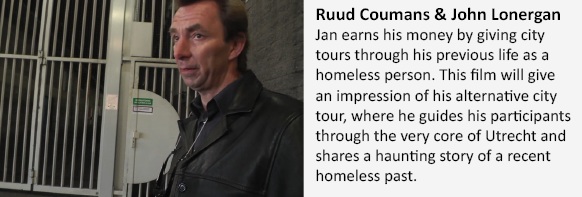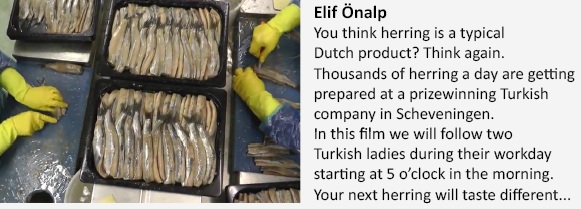Turkish herring, laughter yoga, and taxidermy: Visual Ethnography NL
Mixed media as an ethnographic research method. The Visual Methods Weblab projects 2014 show colorful, creative and accessible films and websites on Dutch society, made by our bachelor students. They also reveal some challenges and ethical implications.
New ways of presenting audio-visual research
Using mixed media to present ethnographic fieldwork is rapidly becoming an accepted practice in anthropology departments that teach hands-on Digital and Visual Anthropology in more and more places around the world. Ethnographic filmmaking has been taught in Leiden since 1966 (Gerbrands), but the digital age has opened up a wide range of new possibilities in the landscape of anthropological communication. This is now the second year that Leiden Visual Methods students have also built their own websites to present the outcomes of their audio-visual research.
Though the students have been trained in writing anthropology for over two years when they embark on their projects, it is still a very new skill for them to integrate these media into their thinking about ethnography in practice, and about its theoretical and ethical implications. In her blog on this site last year, Janine Prins explored some of the various applications and implications in relation to the websites created by the pioneer group of students in 2013. The Visual Methods students of 2014 can build on the example of their predecessors. They too have researched and composed the content of their websites, which will be shown below in five months’ time.
Exciting outcomes
This year the results are no less exciting than the first. We go into the sensorial experience of nature in springtime through the eyes of Sophie Hankinson and Yara Maljers (Experiencing Nature); we enter into the religious experience of singing songs in the church service of a Brazilian community by the name of ‘Servos do Amor’ – the project of Salina Berentsen and Ilse Spruit (Servos do Amor); and , guided by Elva Lilja Horsthuis and Nienke Visser (From Dead to Beast), we engage with the sobering experience of witnessing a taxidermist skillfully stripping and stuffing a parrot’s skin – each website launches us into a different world.
A dinner for international students in Wageningen becomes a cross-cultural experience of tastes, as investigated by Iines Ramark (The Taste of Droevendaal), and in the website by Eva Salman (The New Botanist), an interest in urban agriculture enables growers to venture in new directions. People who, by force or by choice, have ended up living on the streets tell us about their lives in the films and websites of Ruud Coumans & John Lonergan (Homeless tours) and Timo Breure & Floor Link (Carles, a Street Musician). Elif Onalp’s film The hands behind herring gives us a glimpse of what life is like for Turkish women who clean our herrings every day from 5am till the catch requires. And the engaging film by Lieke Kleinsmann, finally – Els and her laughter yoga – shows how laughing can be induced and enjoyed for therapeutic reasons.
The websites themselves were made over a period of six weeks. Each website has its own atmosphere, adjusted to its intended audience. It informs users and invites them to interact with the content. The websites combine serious and systematically obtained research outcomes with recipes for wild vegetables, for instance, or maps that show routes, and links to other websites. And they incorporate films that enable users to engage with the smells and sounds of the worlds of the subjects, the landscape in which they live, and the pace of their movements and emotional development; the digital environment allows for more playful approaches and different modes of engagement.
New directions, new challenges
Using digital media motivates the students to explore new directions and other ways of looking at their research material and approach. For the conventional anthropologist, the plunge into the digital age may still seem daunting; the changes it brings to forms and modes of representation are often experienced as sacrilege. What happens to ethnographic knowledge and understanding and epistemological conventions when you interrelate image and text in a digital environment? What are the consequences for your content and style of writing if you choose to aim your website at a specific audience outside academia? What does this change in terms of ethical considerations vis a vis the people your research involved? How does the use of other media facilitate different modes of collaboration between researcher and subjects, but also with the public ? Today’s students, however, seem to take that plunge effortlessly.
Ethical dilemmas
Nevertheless, the researcher still has to deal with ethical dilemmas, as the individuals who feature as subject in the research remain recognizable. When 16 mm films were still the only medium for making films, access could be restricted and controlled, as the film was a material thing that one had to carry to the place of projection, and copying was a costly matter. With digital media, such control becomes impossible from the moment a production is published. For these reasons, one website and film – a subtle portrait by Sacha Varkevisser and Ivana Barisic of a young Dutch woman who converted to Islam – was locked for outside audiences at the request of the subject of the research.. It is a sad reflection of the times that she was afraid she might be harassed if her choice of religion was brought out into the open.
The various projects can be accessed through the links below:
- From Dead to Beast by Elva Lilja Horsthuis & Nienke Visser
- The Taste of Droevendaal by Iines Ramark
- Servos do Amor by Salina Berentsen & Ilse Spruit
- The New Botanist by Eva Salman
- Experiencing Nature by Sophie Hankinson & Yara Maljers
- Carles, a Street Musician by Timo Breure & Floor Link
- Homeless Tours by Ruud Coumans & John Lonergan
- The Hands behind Herring by Elif Önalp
-
Els and Her Laughter Yoga by Lieke Kleinsmann
From Dead to Beast

Website: http://filmprojectmuseumw.wix.com/vandoodtotdier
The Taste of Droevendaal

Website: http://iinesramark.wix.com/tasteofdroevendaal
Servos do Amor

Website: http://servantsoflove.wix.com/servantsoflove
The New Botanist

Website: http://evaslaman.wix.com/thenewbotanist
Experiencing Nature

Website: http://sophiehankinson.wix.com/experiencingnature
Carles, a Street Musician

Website: http://streetmusicians.wix.com/carlescamell
Homeless Tours

Website: http://jonnylonny.wix.com/homelesstour
The Hands behind Herring

Film: https://www.youtube.com/watch?v=U3A59r_uii8
Els and Her Laughter Yoga





2 Comments
Interesting point you raise, Zane. In my understanding 'users' would participate in the constructions of contents, whereas a 'spectator' (ie audience, consumer, colleague, or whatever) 'only' interprets a given authorial 'text'. There are always three parties at play: the authors, the subject matter and the ones at receiving end.
The defining difference would be in the amount of interactivity involved in the realisation of content. So-called 'traditional' media think in a more linear, one way direction of authorial sending - audience receiving and subject consent. So-called 'new' media are ideally believed to use more open ended, less hierarchical, communication patterns.
Digital media can work in various ways; the fact that something is communicated digitally does not say much, really.
Amazing! Thank you so much for sharing! All the projects sound fascinating and I can't wait to watch the films. And, Im really glad I can do that tonight from the comforts of my couch rather than a screening room ;)
Either way, the questions about digital medium raised here are really important to reflect on. What I am in particular interested is what happens when we think about the viewers as 'users'.. is that different from thinking about them as 'consumers', 'colleagues', etc. and if yes then how?
Add a comment